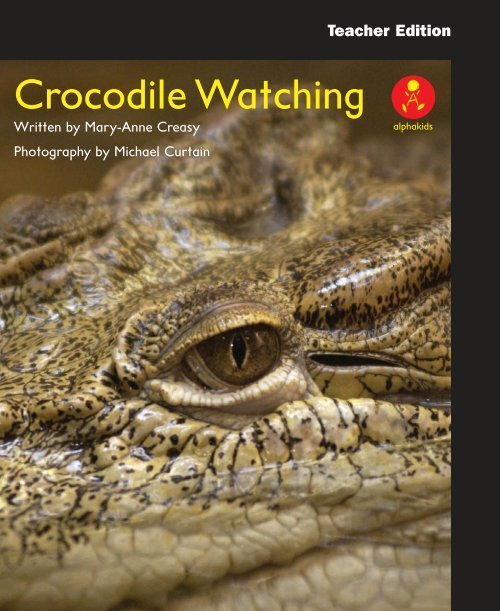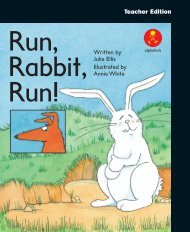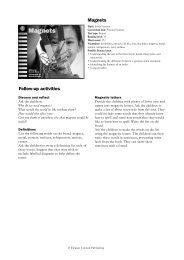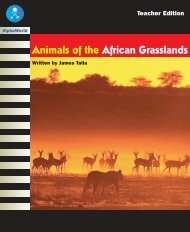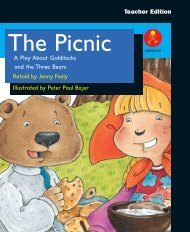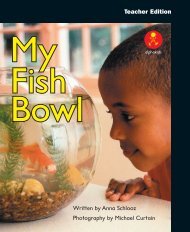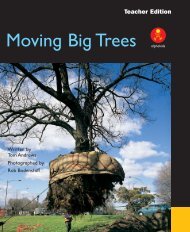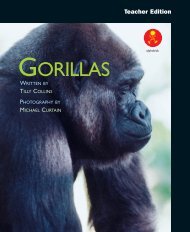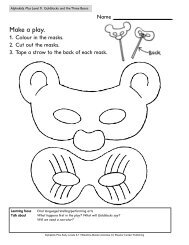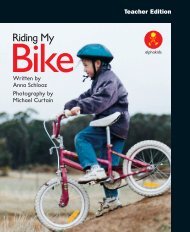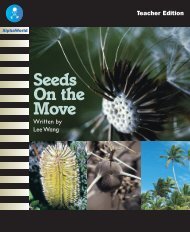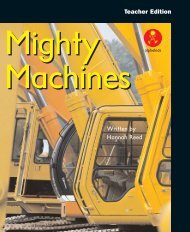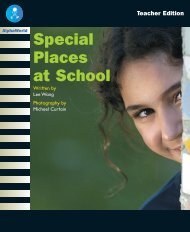L14 TEpp Crocodile Watching
L14 TEpp Crocodile Watching
L14 TEpp Crocodile Watching
You also want an ePaper? Increase the reach of your titles
YUMPU automatically turns print PDFs into web optimized ePapers that Google loves.
Teacher Edition<br />
<strong>Crocodile</strong> <strong>Watching</strong><br />
Written by Mary-Anne Creasy<br />
Photography by Michael Curtain<br />
alphakids
Horwitz Education<br />
A Division of Horwitz<br />
Publications Pty Ltd<br />
55 Chandos Street<br />
St Leonards NSW 2065<br />
Australia<br />
Horwitz Gardner<br />
Education<br />
Unit 53, Cressex<br />
Enterprise Park<br />
Lincoln Road<br />
High Wycombe,<br />
Bucks, HP12 3RL,<br />
United Kingdom<br />
Published edition<br />
© Eleanor Curtain<br />
Publishing 2003<br />
First published 2003<br />
Apart from any fair dealing for<br />
the purposes of study, research,<br />
criticism or review, as<br />
permitted under the Copyright<br />
Act of Australia, no part of this<br />
book may be reproduced by<br />
any process, or transmitted in<br />
any form, without permission<br />
of the copyright owner. Where<br />
copies of part or the whole of<br />
this book are made under Part<br />
VB of the Copyright Act, the<br />
law requires that records of<br />
such copying be kept and the<br />
copyright owner is entitled to<br />
claim payment.<br />
Developed by<br />
Eleanor Curtain Publishing<br />
Text: Jenny Feely<br />
Consultant: Susan Hill<br />
Designed by<br />
Alexander Stitt<br />
Production by<br />
Publishing Solutions<br />
Printed in Hong Kong<br />
ISBN 0 7253 2832 0<br />
Pack ISBN 0 7253 2774 X<br />
(6 Student Books + 1 Teacher<br />
Edition)<br />
1 2 3 4 5 6 7 8 9<br />
03 04 05<br />
?<br />
How to use this book<br />
Before reading: Talkthrough<br />
Talk through the book with the children. Encourage<br />
them to predict the text from the cover and the<br />
pictures, and to think about the information they<br />
provide. Direct the children’s attention to aspects of<br />
the text that may challenge them. Support the children<br />
to deal with these challenges by asking the<br />
Talkthrough questions on each page.<br />
During reading: Observe and support<br />
Observe the children as they read. Encourage them to<br />
monitor their own reading as they comprehend the<br />
text. As needed, support children by assisting them to<br />
discover and use reading strategies and cues to solve<br />
problems and respond to reading challenges that arise<br />
in the text. Interruptions to the child’s reading should<br />
be minimal and focused on a specified learning need.<br />
After reading: Comprehension, returning to<br />
the text, responding and writing links<br />
To further develop children’s understanding of the<br />
text, select from activities found on page 12 and the<br />
inside back cover. These whole text, sentence and word<br />
level activities reinforce the teaching focus of this<br />
book. Assessment ideas are provided to assist with<br />
planning for further teaching.<br />
Text highlights<br />
• <strong>Crocodile</strong> fact sheet<br />
• Colour photographs provide information<br />
about crocodiles in the wildlife park<br />
Vocabulary<br />
crocodile, feed, show, swim, lie, catch, jumps,<br />
splash, move, grab, clean, sweep, watches,<br />
check, fast, big, quickly
Setting the context<br />
Ask: What do you know about<br />
crocodiles?<br />
Draw up a concept web and<br />
ask the children to<br />
brainstorm all that they<br />
know about crocodiles.<br />
Background information<br />
<strong>Crocodile</strong>s are cold-blooded<br />
reptiles. When kept in<br />
captivity crocodiles must be<br />
kept warm. <strong>Crocodile</strong>s are<br />
able to move very fast and<br />
cannot be fully tamed so<br />
handlers must always work<br />
in pairs with one person<br />
working inside the crocodile<br />
enclosure while the other is<br />
watching the crocodile.<br />
Introducing the book<br />
This book is called ‘<strong>Crocodile</strong><br />
<strong>Watching</strong>’. It is about some<br />
crocodiles that live in a<br />
wildlife park. It tells us how<br />
the crocodile keepers look<br />
after the crocodiles.<br />
<strong>Crocodile</strong> <strong>Watching</strong><br />
Written by Mary-Anne Creasy<br />
Photography by Michael Curtain<br />
alphakids<br />
<strong>Crocodile</strong><br />
<strong>Watching</strong><br />
Written by Mary-Anne Creasy<br />
Photography by Michael Curtain<br />
alphakids<br />
Front cover<br />
What is the crocodile doing? Why might it be<br />
watching us? Why has this photograph been<br />
put on the front of the book?<br />
Title page<br />
This is the title page. What does it tell us?<br />
Draw out the features of a title page: title,<br />
picture, author and photographer credits,<br />
and series logo.
<strong>Crocodile</strong> <strong>Watching</strong> Pages 2–3<br />
?<br />
Talkthrough<br />
Point out Greg and Stuart. Look at the other photographs<br />
on the page.<br />
What are these photographs of? What do you think it would<br />
be like to be a crocodile keeper? What things would Greg<br />
and Stuart have to do in their job?<br />
Observe and support<br />
Does the child search for a range of cues as they read.<br />
If the child makes an error:<br />
Try that again and think about what would make sense.<br />
2
Here are Greg and Stuart.<br />
They are crocodile keepers at the<br />
wildlife park.<br />
They look after the crocodiles.<br />
2 3<br />
3
<strong>Crocodile</strong> <strong>Watching</strong> Pages 4–7<br />
?<br />
Talkthrough<br />
Look at the photograph on page 4.<br />
What are the people looking at? What might Greg be telling<br />
and showing them?<br />
Look at the crocodile on page 5.<br />
<strong>Crocodile</strong>s are good swimmers. Can you name two things<br />
that help them to swim fast?<br />
Turn to pages 6–7.<br />
Which parts of the crocodile are under the water? Which<br />
parts are out of the water? How much of a crocodile would<br />
you see in the wild if it were lying in muddy water? How<br />
could this help the crocodile to catch food?<br />
Observe and support<br />
Can the child understand the inferences in the text?<br />
Why would a crocodile in the wild lie with most of its body<br />
under the water?<br />
Why don’t wildlife parks have muddy water for the<br />
crocodiles?<br />
4
<strong>Crocodile</strong>s are very good swimmers.<br />
They have webbed toes to help<br />
them to swim.<br />
They also have a flat tail with fins<br />
to help them to swim very fast.<br />
Many people come to the wildlife park<br />
to see the crocodiles. The keepers show<br />
the people how crocodiles live.<br />
4<br />
5<br />
When crocodiles lie in the water<br />
most of their body is underwater.<br />
Only their eyes, nose and ears<br />
are out of the water.<br />
6<br />
In the wild this makes the crocodiles<br />
hard to see. It helps crocodiles<br />
to catch other animals.<br />
7<br />
5
<strong>Crocodile</strong> <strong>Watching</strong> Pages 8–11<br />
?<br />
Talkthrough<br />
Look at the photographs on pages 8–9.<br />
What is Greg doing here? What do you think is on the end of<br />
the pole? Why has the publisher included four small<br />
photographs of Greg? What do these photographs show us?<br />
Look at pages 10–11.<br />
Why does Greg need to be careful?<br />
What could happen to him?<br />
Observe and support<br />
Does the child read the text with expression?<br />
How might Greg be feeling when he is feeding the crocodile?<br />
What might his voice sound like if he was reading this book?<br />
Can you make your voice sound like that when you read?<br />
6
The keepers feed the crocodiles fish,<br />
rats and chickens.<br />
A crocodile jumps out of the water<br />
to catch some food.<br />
It makes a very big splash!<br />
8<br />
9<br />
Greg shows the people how fast<br />
a crocodile can grab food.<br />
He must be careful because<br />
crocodiles can move very quickly.<br />
10<br />
11<br />
7
<strong>Crocodile</strong> <strong>Watching</strong> Pages 12–13<br />
?<br />
Talkthrough<br />
Greg and Stuart also have to clean the crocodile pit. They<br />
have to sweep it and clean the glass. Why is only one of<br />
them working at a time? What is the other one doing? Why<br />
would they need to have someone watch while the crocodile<br />
pit is cleaned?<br />
Observe and support<br />
Does the child use contextual information to understand<br />
the meaning of new vocabulary?<br />
What is a crocodile pit? How did you work that out?<br />
8
The keepers clean the crocodile pit.<br />
They sweep the pit and clean the glass.<br />
One keeper watches to make sure<br />
that the crocodiles do not come near<br />
the other keeper.<br />
12 13<br />
9
<strong>Crocodile</strong> <strong>Watching</strong> Pages 14–16<br />
?<br />
Talkthrough<br />
How do Greg and Stuart make sure that the air and water in<br />
the crocodile pit are the right temperature?<br />
Look at page 15.<br />
What is Greg doing?<br />
Look at page 16.<br />
Greg and Stuart put the eggs in an incubator to keep them<br />
warm. How long do you think the eggs need to stay in the<br />
incubator? Can you scan the page to work it out? What will<br />
you look for as you scan?<br />
Observe and support<br />
Can the child use phonic understanding to work out new<br />
words such as ‘incubator’?<br />
Can you break up the word? What might that part say? What<br />
sound do you think the word will start with/finish with?<br />
10
Female crocodiles lay eggs once a year.<br />
Greg and Stuart put the crocodile eggs<br />
into an incubator to keep them warm.<br />
They check the eggs every week.<br />
<strong>Crocodile</strong>s need a warm place to live.<br />
The keepers check the temperature<br />
of the air and the water every day.<br />
14<br />
15<br />
<strong>Crocodile</strong> facts<br />
<strong>Crocodile</strong>s can grow up to 7 metres long.<br />
<strong>Crocodile</strong>s have about 70 sets of teeth.<br />
<strong>Crocodile</strong>s can live up to 100 years.<br />
<strong>Crocodile</strong>s have 3 sets of eyelids.<br />
<strong>Crocodile</strong> eggs take about 80 days to hatch.<br />
16<br />
11
<strong>Crocodile</strong> <strong>Watching</strong><br />
Being a meaning maker<br />
Encourage the children to support<br />
their answers with evidence from the<br />
book as they discuss these questions:<br />
What do crocodiles eat?<br />
What do the crocodile keepers need to<br />
do to look after the crocodiles?<br />
Why are crocodiles dangerous?<br />
What should you do if you see a<br />
crocodile in the wild?<br />
Being a code breaker<br />
Children may like to explore the<br />
following language features:<br />
• Verbs: feed, show, swim, lie, catch,<br />
jumps, splash, move, grab, clean,<br />
sweep, watches, check.<br />
• Adverbs: fast, quickly.<br />
• Compound words: wildlife,<br />
underwater.<br />
Being a text user<br />
Review the concept web begun prior<br />
to reading the book.<br />
What could we add to this chart now?<br />
Is there anything that we should<br />
change now that we have read the<br />
book?<br />
What did this book help us to learn<br />
about crocodiles?<br />
What did it help us to learn about being<br />
a crocodile keeper?<br />
Being a text critic<br />
Do all wildlife parks keep crocodiles?<br />
Would you like to be a crocodile<br />
keeper? Why?<br />
12
Responding to text<br />
Children could make a poster<br />
advertising the crocodile exhibit<br />
at the wildlife park. Encourage them<br />
to include information about the<br />
behaviour of the crocodiles, feeding<br />
times, etc.<br />
Children could work in<br />
cooperative pairs to make a<br />
drawing showing all that a wildlife<br />
park needs to provide to keep<br />
crocodiles. Encourage the use of<br />
labels and captions to explain this.<br />
Children could make a list of<br />
verbs to describe crocodile<br />
movements: snap, swim, run, dive,<br />
splash, etc.<br />
Writing links<br />
Shared writing<br />
You may like to ask the children to<br />
brainstorm as you list words that<br />
describe crocodiles. Ask the children<br />
to use several of the words to make up<br />
an oral sentence describing<br />
crocodiles. Have several children<br />
share these with the group. Share in<br />
writing a paragraph describing a<br />
crocodile.<br />
Independent writing<br />
Children could write a description of<br />
an animal without naming it. Other<br />
children work out the animal being<br />
described.<br />
Assessment<br />
Can the child:<br />
• Identify the use of the crocodile fact sheet?<br />
• Explain what they have learned about crocodiles from reading the book?<br />
• Identify the use of descriptive language in the book?<br />
• Give a personal response to the book?<br />
whole text activity sentence activity word activity
<strong>Crocodile</strong> <strong>Watching</strong><br />
Written by Mary-Anne Creasy<br />
alphakids<br />
Photography by Michael Curtain<br />
Teacher<br />
Edition<br />
Other books<br />
at this level<br />
Seahorses<br />
Written by Hannah Reed<br />
alphakids<br />
Topic: Living things<br />
Curriculum link: Science<br />
Text type: Description<br />
Reading level: 14<br />
Word count: 266<br />
Vocabulary: crocodile, feed, show, swim, lie,<br />
catch, jumps, splash, move, grab, clean, sweep,<br />
watches, check, fast, big, quickly<br />
Possible literacy focus<br />
Using a fact sheet.<br />
Using descriptive language: verbs and adverbs.<br />
Providing a personal response to the book: Would<br />
you like to be a crocodile keeper? Why?<br />
Summary<br />
This book is a description about the behaviour<br />
and care of crocodiles at a wildlife park.<br />
Fantastic<br />
Frog Facts<br />
Written by Sarah O’Neil<br />
Snip! Snap!<br />
Written by Lynette Ind Illustrated by Peter Paul Bajer<br />
alphakids<br />
alphakids<br />
Our Classroom<br />
Written by Jack Hastings<br />
Pet<br />
alphakids<br />
Photography by Michael Curtain<br />
The Hungry Baby<br />
Written by<br />
Jenny Feely<br />
Illustrated by<br />
Chantal Stewart<br />
alphakids<br />
ISBN 0- 7253- 2832- 0<br />
9 780725 328320<br />
alphakids


